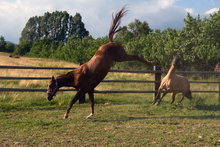Researchers have found that a little exercise helps horses maintain a more cooperative mood with less negative behavior. Original research done at the Equine Centre at Charles Sturt University, Wagga Wagga, New South Wales, Australia, assessed the influence of exercise on stabled horses' behavior. This research has been followed up with other research at universities and other research centers with essentially the same results.

Positive effects of horse exercise
It can safely be reported that just one hour of exercise a day, regardless of the type leaves horses in a more cooperative and less reactive mood.
The study also examined whether four different forms of exercise-walker, treadmill, turnout and recreational riding-were equally effective in reducing unwanted behavior from horses housed in stalls.
It can safely be reported that just one hour of exercise a day, regardless of the type leaves horses in a more cooperative and less reactive mood. A total of 24 horses were involved in the study and each horse's behavior was evaluated while being handled for weighing and then while loading in and out of a trailer.
In the original study ,Dr Raf Freire and his co-workers looked at how stabled horses behaved when they were given an hour's exercise a day compared with no exercise. An important aspect of the study was that each horse acted as its own control in matched treatments. This allowed the researchers to separate the effects of exercise from other effects associated with the exercise treatments.
On the days when they were not exercised, horses were taken out of their stables for an hour for a change of scenery, but no exercise as such. So, for example, horse walker exercise was compared with standing on a stationary horse walker.
Each horse was also released on its own into an arena for 15 minutes while its activity was documented to assess rebound behavior. The researchers considered rebound activity as an indicator of the horse's previous behavioral deprivation, resulting from being confined to a stall. For comparison, during another period when the same horses went without daily exercise, they received the same behavior assessment routine.
Unwanted behavior did not occur often, but for ease of recording was classified as either "dangerous" including bolting, rushing in or out of scales or trailer or "unwelcome" undesirable or uncooperative behaviors not considered dangerous.
There were three instances of dangerous behavior, showing that it does happen even with experienced handlers. However, the numbers of incidents was not enough to allow statistical analysis.
Exercise for an hour a day was sufficient to reduce the rebound effect shown by horses when turned out compared to horses that had not been exercised with turnout appearing to be the most effective for reducing the number of steps taken at canter, and the number of bucks and rolls.
Exercise also reduced significantly the amount of problem behavior during the routine tasks, and the amount of vocal commands that the handler had to give the horses during these tasks.
The researchers conclude: "Providing stabled horses with one hour a day of exercise on a walker, treadmill, turn-out or being ridden are all effective in providing for the general exercise needs of stabled horses, and is likely to provide positive effects on horse welfare, training ability and handler safety."
Information taken from: Effects of different forms of exercise on post inhibitory rebound and unwanted behavior in stabled horses. R Freire, P Buckley, JJ Cooper
Equine Vet J (2009) 41, 487 - 492
